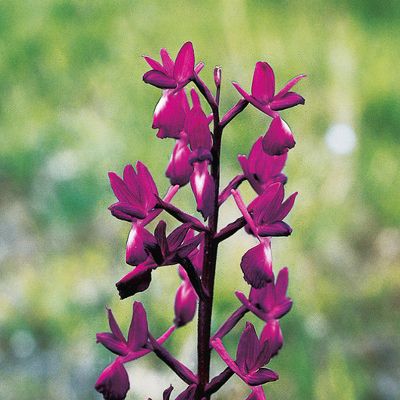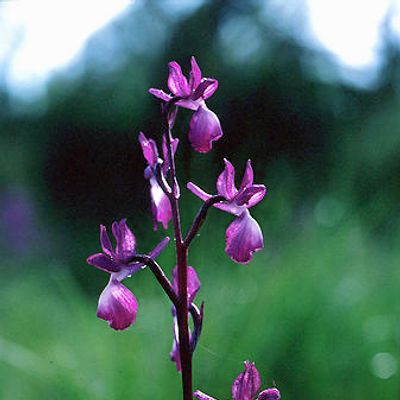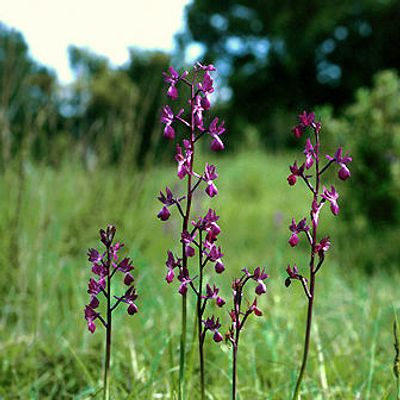Orchis laxiflora Lam.
1031340
Species
ISFS : 280700
Checklist : 1031340
ISFS : 280700
Checklist : 1031340
Contains :
Synthesis
Species description (© Flora Helvetica 2018)
Ähnlich wie O. palustris, aber Blüten dunkel purpurviolett, Lippe sattelförmig, mit nach unten gebogenen Seitenabschnitten (bei O. palustris Lippe +/- flach), Mittellappen sehr kurz, höchstens so weit nach vorne ragend wie die breiten Seitenabschnitte (bei O. palustris Mittellappen die Seitenlappen überragend), Sporn horizontal oder etwas aufwärts gebogen, an der Spitze gefurcht (bei O. palustris ohne Furche).Flowering period (© Flora Helvetica 2018)
5Habitat and distribution inside Switzerland (© Flora Helvetica 2018)
Sumpfwiesen / kollin-montan / Südliches TIWorld distribution (© Flora Helvetica 2018)
MediterranEcological indicator (© Landolt & al. 2010)
4+w+22+44+2.g.2n=36Status
IUCN status
Critically endangered (Possibly Extinct)National Priority
2 - high national priorityInternational responsibility
1 - weakConservation
Threats
Eutrophierung
Beweidung, Konkurrenz
Freizeitaktivitäten, Fotografen (Tritt)
Entwässerung
Kleine isolierte Population (Datendefizit)
Distribution map
Habitat and distribution inside Switzerland
Südliches TIWorld distribution
MediterranEcology
Life form
Geophyte
Habitats
Milieux Phytosuisse (© Prunier et al. 2017)
Habitats © Delarze & al. 2015
 | 2.3.1 - Pfeifengraswiese (Molinion) |
bold
Dominant species, influencing the appearance of the habitat
 Character species
Character species
 Less strictly linked to a specific habitat
Less strictly linked to a specific habitat
Ecological indicator values by © Landolt & al. (2010)
| Soil factors | Climatic factors | Salinity tolerance | |||
|---|---|---|---|---|---|
| Humidity Value H | 4+w+ | Light Value L | 4 | Salinity Index | 1 |
| Reaction Value R | 2 | Temperature factor T | 4+ | ||
| Nutriments value N | 2 | Continentality K | 2 | ||
- Ecological values legend
Humidity Value H 1 very dry 1+ dry 2 moderatly dry 2+ moist 3 medium wet 3+ wet 4 very wet 4+ soggy 5 submerged or underwater f plants living in running water u mostly submerged plants v partly submerged, partly floating plants w humidity moderately variable (± scale of 1-2) w+ highly variable humidity (scale exceeding ± 2) Reaction Value R 1 Very acid (pH 2.5-5.5) 2 acid (pH 3.5-6.5) 3 lightly acid to neutral (pH 4.5-7.5) 4 neutral to basic (pH 5.5-8.5) 5 basic (pH 6-5 -> 8.5 Nutriments value N 1 very low in nutrients 2 low in nutriments 3 medium-poor to medium-rich in nutrients 4 rich in nutriments 5 very rich in nutriments Salinity tolerance 1 halotolerant 3 halophyle Light Value L 1 very shady 2 shady 3 lighted areas 4 luminous 5 highly luminous Temperature factor T 1 alpine to nival stages (from the treeline to the snowline) 1+ suprasubalpine and upper subalpine levels (pine and larch forests) 2 subalpine level (coniferous forests without beeches up to the upper limit of spruces) 2+ lower subalpine and upper mountain stages 3 mountain level (beech and silver fir forests, in the central Alps Scots pine forests) 3+ lower mountain and upper hill levels 4 hill level (mixed deciduous oak forests) 4+ hot places, hill level 5 very hot places, hill level (only in the hottest places, typical of southern Europe) Continentality K 1 Atlantic (high air humidity, very low temperature variations, mild winters) 2 Sub-Atlantic (high air humidity, low temperature variations, relatively mild winters) 3 sub-Atlantic to subcontinental (average air humidity, moderately variable temperature, slightly low winter temperatures) 4 subcontinental (low air humidity, large temperature variations, rather cold winters) 5 continental (very low air humidity, very large temperature variations, cold winters)
Water dependency
| Rivers | 1 - Secondary habitat |
| Calm water | 1 - Secondary habitat |
| Ground water | 0 - No link |
Nomenclature
Accepted Name (Checklist 2017)
Orchis laxiflora Lam.
Vernacular name
Deutscher Name :
Lockerblütiges KnabenkrautNom français :
Orchis à fleurs lâchesNome italiano :
Orchide acquaticaMatch with other reference books
| Relation | Nom | Book | No |
|---|---|---|---|
| = | Orchis laxiflora Lam. | Checklist 2017 | 280700 |
| = | Orchis laxiflora Lam. | Flora Helvetica 2001 | 2994 |
| = | Orchis laxiflora Lam. | Flora Helvetica 2012 | 2579 |
| = | Orchis laxiflora Lam. | Flora Helvetica 2018 | 2579 |
| = | Orchis laxiflora Lam. | Index synonymique 1996 | 280700 |
| = | Orchis laxiflora Lam. | Landolt 1977 | 772 |
| = | Orchis laxiflora Lam. | Landolt 1991 | 678 |
| = | Orchis laxiflora Lam. | SISF/ISFS 2 | 280700 |
| = | Orchis laxiflora Lam. | Welten & Sutter 1982 | 2559 |
= The taxon corresponds to the accepted taxon (Checklist 2017)
< The taxon is included in the accepted taxon (Checklist 2017)
> The taxon includes (among others) also the accepted taxon (Checklist 2017)
< The taxon is included in the accepted taxon (Checklist 2017)
> The taxon includes (among others) also the accepted taxon (Checklist 2017)
Status
Native status
-IUCN list of endangered species (© Walter & Gillett 1997) : No
Status on national Red List 2016
IUCN status:
Critically endangered (Possibly Extinct)
.png)
Additional information
IUCN criteria: --
Status on regional Red List 2019
| Biogregraphic regions | Status | IUCN criteria |
|---|---|---|
| Jura (JU) | -- | |
| Mittelland (MP) | RE | |
| Alpennordflanke (NA) | -- | |
| Alpensüdflanke (SA) | CR(PE) | |
| Östliche Zentralalpen (EA) | -- | |
| Westliche Zentralalpen (WA) | -- |
- Legend
EX Extinct RE Regionally Extinct CR(PE) Critically Endangered, Probably Extinct CR Critically Endangered EN Endangered VU Vulnerable NT Near Threatened LC Least Concern DD Data Deficient NE Not Evaluated NA Not Applicable
National Priority Species List Status
| National Priority | 2 - high national priority |
| Need to take action | 99 - |
| International responsibility | 1 - weak |
| Need to monitor populations | 1 - |
Protection status
| International (Bern Convention) | No | |
| AG | total protection | (01.01.2010) |
| FR | total protection | (12.03.1973) |
| Switzerland | total protection | |
| GE | total protection | (25.07.2007) |
| TI | total protection | (23.01.2013) |
- Disclaimer
InfoFlora compiles information on protected species as accurately as possible, taking it from the respective cantonal laws. In some cases, however, it was not possible to use the plant names as listed in the original text, but an interpretation of their taxonomy or nomenclature was necessary. The exact meaning of the categories „completely protected“ and „partially protected“ differs among the cantons.
InfoFlora cannot guarantee that the information on the protection status is correct and complete. In case of doubts, we recommend to look up the texts of the respective cantonal law.
Status by sector of activity
| Agriculture-related environmental objectives : | more informations | |
| Forest management environmental objectives : | more informations |
Conservation
Threats and measures
Eutrophierung
Keine Düngung
Pufferzonen einrichten
Absprachen über Pflegemassnahmen mit dem Eigentümer, dem Bewirtschafter und der Gemeinde
Beweidung, Konkurrenz
Beweidung einstellen
allfällige, wieder auftauchende Exemplare durch kleinflächige Gitterabzäunung schützen
im Herbst mähen
Streue entfernen
Freizeitaktivitäten, Fotografen (Tritt)
Einzäunung der Fundstelle
Besucherlenkung durch Informationstafeln
Schutz der Jungpflanzen
Entwässerung
Keine Entwässerung
Kleine isolierte Population (Datendefizit)
Letzte Fundstelle regelmässig absuchen
Wiederansiedlungen sind problematisch
falls noch Exemplare vorhanden wären, ist jedoch Ex situ-Kultur zu veranlassen
Erfolgskontrolle der Massnahmen gewährleisten



